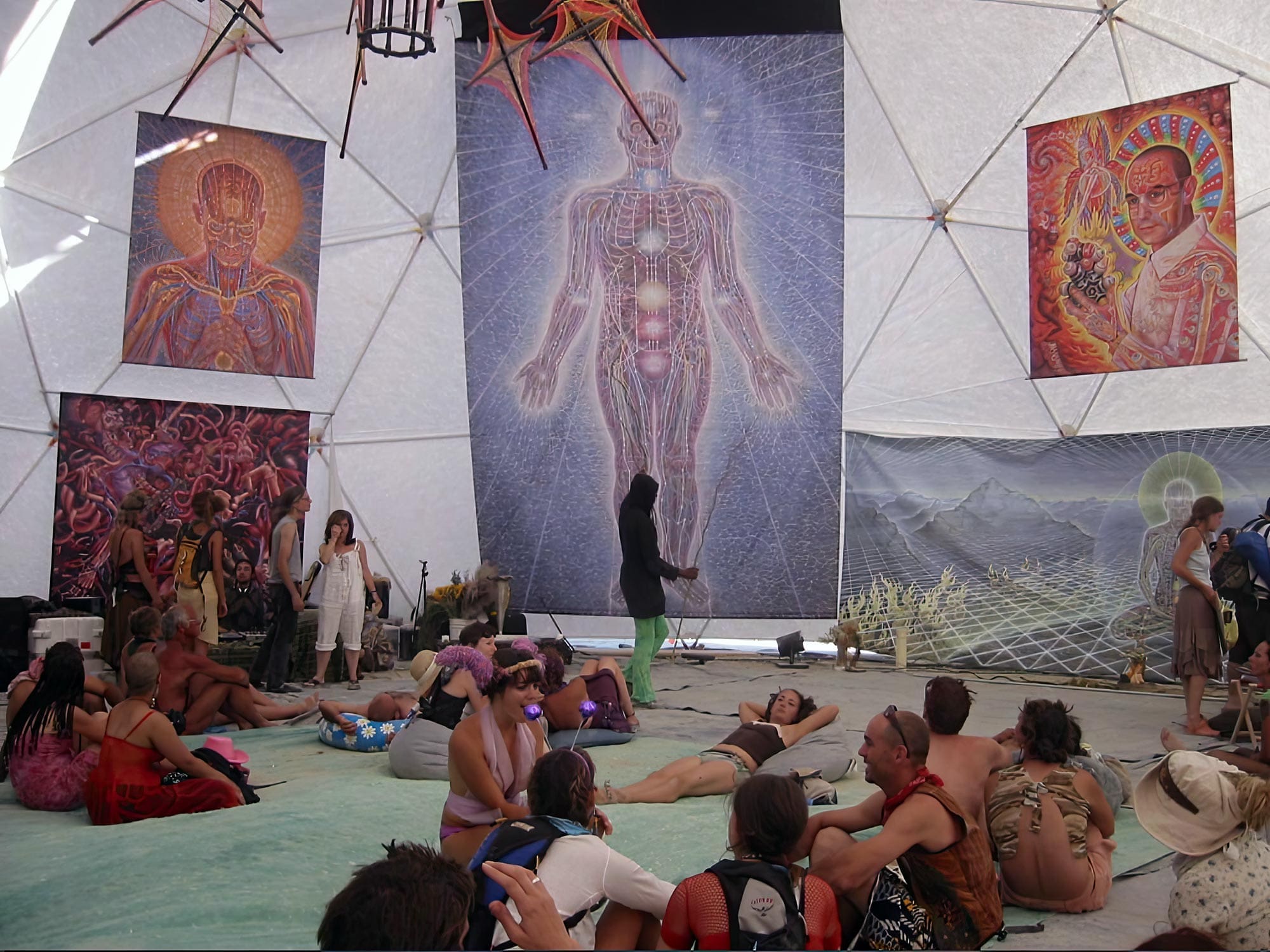Into the Infinite: The Awakening of Alex Grey
In the world of art, few creators truly transcend the boundaries of perception, pushing beyond what is seen to reveal what is deeply felt. Alex Grey, the visionary artist whose work merges the tangible with the metaphysical, stands as a beacon. His art awakens the soul, reaching into the deepest layers of human consciousness that paints a reality somewhere between this world and the next.
Known best for his intricate collaboration with the band Tool, Grey’s creations have become synonymous with both spiritual awakening and psychedelic exploration. For many, including myself, it was through the haunting and mesmerizing visuals of Lateralus that I first discovered the profound nature of his work. Grey’s art is more than just album covers and paintings; it is an ongoing conversation with the infinite, with the unseen forces that shape our existence.
Through the lens of his artwork, Grey guides us through inner landscapes, forcing us to confront the vastness of the universe that exists within ourselves. He speaks to something ancient, yet unknown, drawing viewers into a sacred space of self-reflection, transformation, and transcendence. His journey, one that is as much spiritual as it is artistic, invites us to join him in exploring the possibilities of consciousness.
This is Alex Grey’s story—a visionary, a spiritual guide, and an artist whose work redefines the limits of creativity.
Foreword by RIOT Executive Creative Director and Founder Chris “MUG5” Maguire
“The creative principle is less about dogma and more about opening ourselves to the evolution of consciousness.” — Alex Grey
The Seeds of Vision: Alex Grey’s Early Life and Influences

Alex Grey art portrait with his visionary artwork in the background. Image by alexgreycosm from Wikimedia Commons, licensed under CC BY-SA 3.0.
Long before Alex Grey became known as the artist who bridged the visible and invisible worlds, his journey was one of quiet, profound introspection. Born in 1953 in Columbus, Ohio, Grey’s early years were marked by a deep fascination with life’s mysteries—a curiosity that would later bloom into his renowned artistic vision. Raised in a world where the physical and the spiritual were often seen as separate, Grey sought to bring them together, to show that both realms are inextricably linked in the human experience.
Grey’s passion for art began at a young age, but it wasn’t until his exposure to the transcendental works of mystics, spiritual teachers, and philosophers that his own vision began to take shape. His early influences, which ranged from traditional religious iconography to the vivid, psychedelic imagery of the 1960s, formed the foundation for what would become his signature style—art that explores the human body, mind, and spirit as interconnected forces.
One of Grey’s most transformative experiences was his involvement in Harvard’s psychopharmacology department, where he worked with Dr. Stanislav Grof, a pioneer in the field of transpersonal psychology. This period introduced Grey to the use of altered states of consciousness, including psychedelic substances, as a way to access deeper truths about human existence. It was this blend of scientific inquiry and spiritual exploration that fueled Grey’s artistic evolution.
As Grey reflects in his TED talk, “Art has the power to heal, to transform, and to transcend. When we create art, we tap into something far greater than ourselves.” His work is a reflection of that philosophy, each piece a portal into the infinite, inviting viewers to explore the deeper dimensions of their own consciousness.
From the very beginning, Alex Grey’s art was never just about the external world—it was about what lies beneath, within, and beyond. His influences, a potent mix of spirituality, science, and personal exploration, laid the groundwork for the ethereal mastery that would define his career.
“Art can bridge the gap between everyday reality and the mystical realms.” — Alex Grey
Transcending Sound: The Cosmic Partnership Between Alex Grey and Tool
Few collaborations in the world of music and art have resonated as deeply as the partnership between Alex Grey and the progressive metal band Tool. Their union is not just one of aesthetics, but of philosophy—an exploration of consciousness, the nature of existence, and the infinite. For both Grey and Tool, their work reaches far beyond the traditional confines of their mediums. Together, they created art that invites the viewer and listener into a shared journey through the mysteries of life.
The collaboration began with Tool’s 2001 album Lateralus, a record known for its intricate rhythms, metaphysical themes, and profound lyricism. Grey’s artwork for the album became just as iconic as the music itself, with his now-famous rendering of the human body in a series of sacred, anatomical layers. His art mirrored the band’s exploration of the physical, emotional, and spiritual layers that make up the human experience.

The striking album artwork for Tool’s Lateralus by visionary artist Alex Gray, representing the connection between human anatomy and the infinite.
Grey’s understanding of the body as “the box that consciousness comes in” was a perfect reflection of Tool’s message in Lateralus—a record that challenges listeners to look beyond the surface of reality and question the nature of their own existence. The album’s visual representation became a tool (pun intended) for introspection, with Grey’s art providing a gateway into the deeper messages embedded in the music.
“Alex’s artwork is an embodiment of our message. It’s not just something to look at, it’s something to experience. His visuals align perfectly with what we aim to communicate through our music: transcendence and the journey beyond what we know.” — Maynard James Keenan
Beyond Lateralus, Grey continued to collaborate with Tool on subsequent albums, including 2006’s 10,000 Days, where his intricate designs once again captured the profound, psychedelic energy of the music. Grey’s use of geometric forms, fractals, and sacred symbolism echoed the band’s experimentation with altered states of consciousness and spiritual transformation. The album, which takes its name from the 10,000 days it took lead vocalist Maynard James Keenan to evolve emotionally and spiritually, is a reflection on personal growth, grief, and the long road to healing.
Grey’s artwork for 10,000 Days continues his exploration of spiritual transformation, vividly portraying themes of transcendence and awakening. At the heart of the cover art is the depiction of a figure surrounded by radiant, geometric forms, which Grey refers to as “godheads.” These godheads represent the divine, enlightened state that exists within each individual, gazing outward through layers of anatomical and spiritual awareness.

The godhead artwork by Alex Gray for Tool’s 10,000 Days album, representing the divine and interconnected nature of consciousness.
“We’ve always been interested in the sacred geometry that Alex uses in his work. The album art for 10,000 Days is more than a cover, it’s a visual representation of the themes of healing, growth, and the passage of time that the music explores.” — Adam Jones, Tool guitarist
The godheads, with their many eyes and interconnected patterns, symbolize the omniscience and interconnectedness of all beings. Grey’s signature anatomical renderings are present here, diving deeper into the soul’s evolution, revealing the intricate relationship between body, mind, and spirit. Each layer reflects the complexity of human existence, while the godheads serve as guides, inviting the viewer to explore their own consciousness on a transformative journey. As listeners move through the sonic landscape of the album, the artwork provides a visual representation of the emotional and spiritual themes in the music. Grey’s godheads symbolize the potential for healing and transcendence, resonating deeply with those grappling with pain, grief, and the search for enlightenment. Much like the music of 10,000 Days, the art calls for introspection and invites listeners to explore the cosmic and personal dimensions of their experiences.
Keenan used the album as a vehicle to process his mother’s death and the personal pain he carried for many years. Grey’s artwork serves as a visual representation of this deeply emotional experience, capturing the essence of endurance, suffering, and ultimate spiritual release. The intricate layers of his work, much like the album itself, encourage reflection on life’s most profound questions.
For fans, the visual and auditory pairing of Grey’s artwork and Tool’s music is nothing short of transcendent. Together, they offer a multisensory experience, one that speaks to the complex process of emotional evolution. Just as Keenan used the album to let go of his pain, Grey’s art invites us to examine our own inner struggles and find beauty in the journey. For both Tool and Alex Grey, their art is about more than sound and visuals—it’s a shared vision of the universe, a unified exploration of the infinite possibilities of human experience. Their collaboration not only transformed the visual aspect of album art but also redefined the relationship between music and imagery, creating a profound multisensory experience that continues to inspire fans around the world.
Beyond the Canvas: The Lasting Impact of Alex Grey’s Vision
Alex Grey’s art transcends the confines of traditional visual mediums, inviting viewers into a space of reflection, healing, and connection with the greater cosmos. While his work with Tool garnered widespread attention, his influence extends far beyond the album covers and stages of progressive metal. Grey has become a guiding force for artists, musicians, and spiritual explorers who seek to engage with the metaphysical and the infinite.
Grey’s ability to visually articulate spiritual concepts through intricate details and sacred geometry has resonated with creatives across various disciplines. His work is frequently cited as an inspiration by painters, digital artists, musicians, and filmmakers who seek to explore consciousness and the deeper layers of human experience in their own work. His iconic Sacred Mirrors series, in particular, has sparked widespread reflection on the interconnectedness of body, mind, and spirit.
Beyond the visual arts, Grey’s presence has been deeply felt in the world of psychedelia and consciousness exploration. As a long-time advocate for the use of psychedelics as tools for spiritual awakening, his work continues to be showcased at festivals such as Burning Man and events centered around visionary art. Grey’s art, often displayed in communal, spiritual, and immersive environments, allows audiences to experience not just the visuals but the energy of transformation that they carry.

The Sacred Mirrors artwork by Alex Gray on display in the Chapel of Sacred Mirrors (COSM), representing the connection between body, spirit, and the divine. Image by Melissa Garcia from Wikimedia Commons, licensed under CC BY-SA 3.0.
“A work of visionary art can shock a person out of their normal thinking patterns and help them to see the world in a new way, helping them to transfigure their perception of reality.” — Alex Grey
Grey’s influence can also be seen in the rise of modern sacred art movements, where artists integrate spiritual symbolism and geometric forms into their creations. This revival of sacred geometry and spiritual motifs in contemporary art has flourished, with Grey standing as one of the most significant and well-known figures in this space.
From progressive rock stages to spiritual retreats, Alex Grey’s art has carved out a place in the modern consciousness. His work continues to challenge, inspire, and transform, offering us a glimpse into the infinite potential of human creativity and the mysteries that lie beyond the visible world.
The Spiritual Dimension: Psychedelics, Consciousness, and Sacred Art
Alex Grey’s work lies in a deep exploration of consciousness, the unseen realms of existence, and the mysteries that bind the human experience. This spiritual dimension is woven into every stroke of his brush, every layer of his intricate designs. It’s no surprise that Grey has long been an advocate for the use of psychedelics as a tool for expanding consciousness and reaching higher states of awareness. For Grey, the use of psychedelics is not simply about achieving an altered state, but about accessing deeper truths. Grey’s experience with psychedelics, particularly with substances such as LSD and DMT, has profoundly influenced his art. Beyond the canvas, Grey and his wife Allyson founded the Chapel of Sacred Mirrors (COSM), a spiritual center where art, consciousness, and community converge. COSM has become a sanctuary for spiritual seekers and visionaries, offering a space to reflect, heal, and explore the deeper dimensions of life. Grey’s art, prominently displayed throughout COSM, serves as a visual gateway into these mystical realms.

Participants gather at COSM under Alex Gray’s visionary artwork, exploring consciousness and spirituality. Image by Smoobs, licensed under CC BY 2.0.
“Alex and Allyson Grey’s influence on psychedelic culture has been unparalleled… the inclusion of his artwork in the Burning Man structure in 2006 essentially anointed his chosen status as this generation’s most important psychedelic artist.” — James Oroc, Counter-Culture Historian
As the spiritual and psychedelic movements continue to intersect with modern culture, Grey’s work remains a powerful symbol of the transformative potential of consciousness expansion. His advocacy for the responsible use of psychedelics as spiritual tools has made him a key figure in the modern-day conversation around psychedelics and their role in personal and collective evolution. In a world that often feels fragmented and disconnected, Grey’s art offers a reminder of our inherent unity—both with each other and with the cosmos, calling us to awaken to the greater mysteries that lie beyond the visible, and to embrace the infinite possibilities of consciousness.

Alex Grey painting live at a festival, working on one of his visionary pieces. Image by justthismoment from Wikimedia Commons, licensed under CC BY-SA 3.0.
Ripple Effects: Alex Grey’s Influence
Alex Grey’s visionary art is far more than a collection of striking visuals—it has become a catalyst for a new generation of artists, musicians, and creators who seek to push beyond conventional boundaries. His ability to blend spiritual concepts, sacred geometry, and human anatomy into a unified whole has inspired creatives across multiple disciplines, from the fine arts to music, fashion, and digital design.
Grey’s work speaks to those who desire not only to create but to awaken consciousness and explore the depths of the human experience. In the world of music, Grey’s collaborations with Tool are just the tip of the iceberg. His art has influenced other musicians who explore similar themes of spirituality and transcendence in their sound. His visually immersive work has also become a staple in live music experiences, often appearing at festivals such as Burning Man and Electric Forest, where digital projections of his art turn concert spaces into sacred spaces of transformation.
Grey’s influence extends into fashion as well, with designers incorporating his intricate, symbolic visuals into apparel collections that seek to merge the esoteric with the aesthetic. The rise of visionary art in streetwear culture can, in part, be attributed to Grey’s impact, as his work continues to resonate with those seeking to express spirituality through clothing and accessories.
In the digital age, Grey’s art has become a foundational reference for digital artists and animators working in the realms of virtual reality (VR) and augmented reality (AR). His use of complex geometries and layers of consciousness provides the perfect inspiration for creators seeking to design immersive worlds that allow viewers to step into alternate realities. Grey’s art has also been the subject of animated adaptations and digital experiences, allowing viewers to journey deeper into his visionary landscapes in an interactive way.
“Alex Grey’s art, with its New Age symbolism and medical-illustration finesse, might be described as psychedelic realism—a kind of clinical approach to cosmic consciousness.” — Holland Cotter, New York Times
Whether it’s through traditional mediums or the cutting edge of technology, Alex Grey’s influence is unmistakable. His work has sparked a renaissance of sacred art, where spiritual symbols, cosmic patterns, and deeply personal reflections merge to create something that transcends the visual and touches the soul. As modern creatives continue to seek out new ways to express the unseen, Grey’s legacy as a pioneering visionary artist remains a guiding light, showing the infinite possibilities of creativity.
The Infinite Journey: Alex Grey’s Lasting Legacy
For Alex Grey, the journey of creativity is infinite. His work reminds us that art is not merely a reflection of the visible world but a bridge to the unseen dimensions of existence. In a world that is constantly changing, Grey’s art offers a timeless reminder of our collective potential to grow, transform, and awaken to the greater mysteries of life. As we look to the future, Alex Grey’s legacy will undoubtedly continue to inspire those who seek to explore the unknown, challenge the limits of creativity, and connect with the deeper truths of the universe. His work stands as a beacon for future generations, lighting the way for those brave enough to venture into the infinite possibilities of human consciousness and creativity.
At RIOT creative agency, we are inspired by Alex Grey’s boundary-pushing approach to art and spirituality. Just as Grey’s work transcends traditional mediums to explore deeper dimensions, we too strive to challenge conventions and elevate creativity to new heights. Whether in filmmaking, design, art, music or digital experiences, we channel the same visionary spirit to craft work that resonates on a profound level, shaping not only what people see but what they feel. In the same way Grey’s art serves as a bridge between the physical and metaphysical, RIOT exists to connect creativity with purpose. As we continue to explore the possibilities of design, media, and storytelling, we are guided by the desire to create experiences that inspire and transform. Like Grey, we believe in pushing beyond the limits of what’s possible—venturing into the unknown to unlock the full potential of human creativity.




